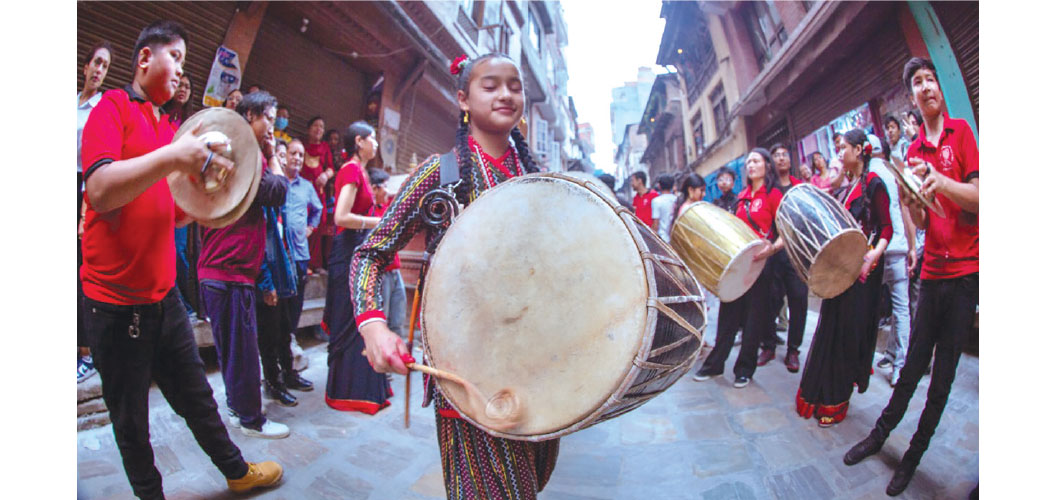
SATV 20 April, Kathmandu: Once thought to be fading under the pressures of urbanisation and modern distractions, the centuries-old cultural rituals of Kathmandu’s Newar community are now witnessing a vibrant resurgence -- led by the very generation once believed to be drifting away from their tradition.
From the historic alleys of Kathmandu Valley to Newar settlements in towns like Tistung, Dolakha, Bahrahbise, Bandipur, Chitlang and even in countries abroad, jatras and festivals once confined to the heart of the capital valley are now celebrated with a sense of renewed pride and enthusiasm.
Looniva Ranjit, 17, recalls the first time she wrapped her hands around a Dhime (traditional musical instrument of Newars) at the Sheetalamai Bhajan Khala. The group offers a three-month course in traditional music, where the youth learn a range of traditional rhythms, known as ‘bol’, central to Newar celebrations and festivals.
For her, the classes have been more than just music lessons, they’ve transformed her social life and deepened her connection with her roots. "Nowadays, many young people have lost touch with our mother tongue, but music goes beyond language," she said. "It’s a way to communicate with the community, not just during festivals and jatras, but also in our everyday lives."
According to her, learning traditional music has helped her build new friendships and connect with her community. "We don't go outside and play as much anymore. We are usually glued to digital screens," she said. "But in course of these classes, I met people of all ages, from children as young as 10 to elders. It is fun, refreshing and a great way to exchange experiences. Additionally, it helps us learn about our rich heritage.”
Before she learned the traditional music, she would just watch jatras. Now, she plays and dances during them, making the experience feel deeply personal. “When I play during the jatra, it feels like I am directly getting connected to the deities,” she said.
Beyond the drum circles and bhajan classes, the Newar community today is embracing their identity in more visible ways. During festivals, the streets come alive with women dressed in ‘haku patasi’ (black sarees) and men in ‘tapalan’ (traditional tunic), the vibrant colours, a strong visual reminder that cultural pride has found new space in modern Nepal.
Moreover, the revival is not limited to music. As part of this new cultural awakening, communities are organising traditional Newar cuisine competitions, dance contests and even workshops on traditional dresses and crafts. This blend of learning, practice, and performance has allowed young Newars to rediscover traditions while making them relevant for today’s world.
One tradition that has made a strong comeback is the use of traditional Newar instruments during wedding processions or ‘janti’. Once sidelined by modern brass bands, the rhythmic sounds of Dhime, Dhaa, Basrui and Naya Khin are now being played during the weddings and other ceremonies. For many, this shift represents more than a musical choice, it symbolises a return to authenticity and pride in one's roots.
Culture photographer Manoj Ratna Shahi, who has documented this gradual transformation over decades, believes the revival stems from both social and political changes. He recalls a time when jatras were conducted solely by elder male members of the community. “In the past, girls were never seen pulling chariots or learning traditional instruments except for ‘Misa Bhu’ during Rato Machhindranath Jatra,” he said. “But that has changed now. Girls, boys, elders, women and even small children actively participate. In the Valley, something once unimaginable -- women pulling chariots -- has become a common sight during Indra Jatra and Seto Machhindranath Jatra. It is now an open space for all.”
Shahi attributes part of this revival to proactive local government. "Thanks to the local government, especially after the first local-level elections in 2017, there have been efforts to preserve and promote our culture and heritage. With dedicated budgets for cultural programmes and trainings, many new groups have been formed to preserve traditions and pass them on to the next generation,” he said.
As stated above, this cultural revival is visible not only in Kathmandu but across Nepal and even in the Newar diaspora abroad. In the past, guthis -- traditional social organisations responsible for cultural and religious activities -- played the dominant role in preserving Newar customs. Today, however, community-based groups, music schools and bhajan khalas have opened up these traditions to anyone with interest, regardless of caste, gender or family lineage.
For 22-year-old Nischal Maharjan, who began his journey with traditional music at age seven through his guthi, ‘Wongha Twa,’ at Indra Chowk, music has become part of his identity. “Learning music is more than just playing instruments. It’s a way of knowing your heritage and it fills you with pride. I learned varieties of instruments like Dhime, Dhaa, Basruri, Khin and others, all of which have their own significance in different festivals,” he said.
“Before we even start learning the instruments, our elders perform a puja and hand musical instruments over to us -- it’s ceremonial, like being assigned a sacred duty,” he said. From there, we learn rhythms which carried their own meaning like the solemn ‘seeh bajan’ for funerals, the celebratory ‘dhime bajan’ for jatras and the devout ‘gunla bajan’ for the Gunla festival.
He said, “We also stand as a bridge between generations -- inheriting traditions from our elders and preparing to pass them on to those who come after us. When we play in jatras, we don’t just make noise, we embody our history.”
Beyond the cultural knowledge, he said, these practices have shaped his social life too. “There’s this unspoken rule; if one of us is playing in the jatra, the rest will too. Missing out feels like the biggest FOMO of all.”
The role of guthis has also evolved. Traditionally, they were responsible for maintaining communal rituals and properties. But as urban lifestyles fractured these bonds with herigate, new community-based music groups stepped in to fill the gap.
Arbindra Man Singh, President of the Newa Dey Daboo Kathmandu, said cultural participation has become so popular that it is now seen as something trendy. “Wearing traditional Newar dress, participating in festivals, playing instruments, it’s not just cultural anymore, it’s fashionable,” he said.
In the past, learning traditional music was often restricted to certain family lines, mostly males. But today, the doors have opened wide, girls and younger children are just as welcome. The availability of digital tutorials and community-based classes has further dismantled the old barriers.
Singh shared an example of a friend who enrolled his son in a community group that teaches traditional Newar music, rather than sending him to a guthi. He said that while guthis often follow a system rooted in lineage and usually accept members based on clan or family ties, community groups like bhajan khalas are open to everyone, regardless of their background. According to him, this inclusive approach has made it easier for more young people to connect with their culture and traditions without the limitations of ancestral affiliations.
Beyond Kathmandu, even the Newar diaspora is keeping traditions alive. Sanyukta Shrestha, President of the World Newa Organisation (WNO), currently living in UK, said that cultural celebrations abroad have become essential for community strength and mental well-being. “Living away from Nepal, people crave for a sense of belonging,” he said. “When we organise jatras, symbolic chariots, masked deities, or traditional feasts overseas, it helps rebuild that connection. It lessens loneliness and creates a familiar environment, even far from home.”
“When you live abroad, you long for home,” Shrestha said. “Even organising a festival in a smaller form helps the next generation understand where they come from. It combats homesickness, reduces isolation and strengthens community bonds.”
Whether in Nepal or across oceans, the collective revival effort has fostered a new cultural consciousness. Community leaders agree that social media, stronger institutional support and growing public pride are fueling this generational return to tradition.
“This isn’t just nostalgia,” he said. “This is about ownership, a new generation realising that culture isn’t something they inherit, but something they must actively preserve.”
From the booming drums of jatras to the sweet taste of ‘yomari’ on Yomari Punhi, the revival of Newar festivals and traditions signals not just survival, but a thriving, evolving cultural advancement heartbeat in the modern age.












